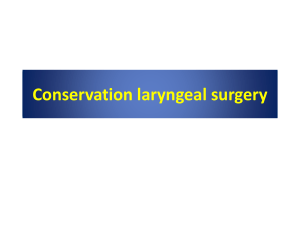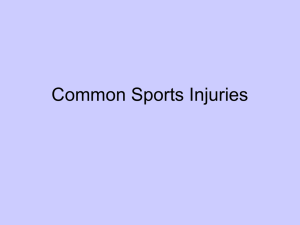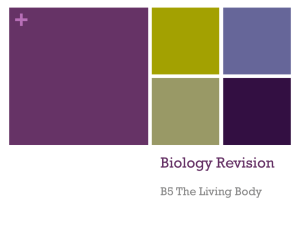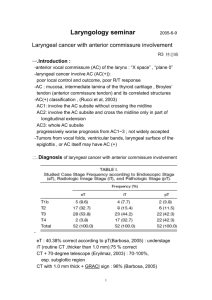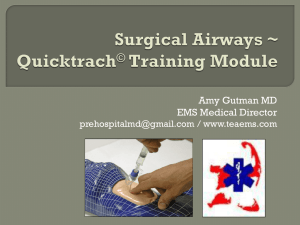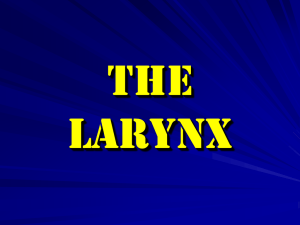Conservation laryngeal surgery
advertisement
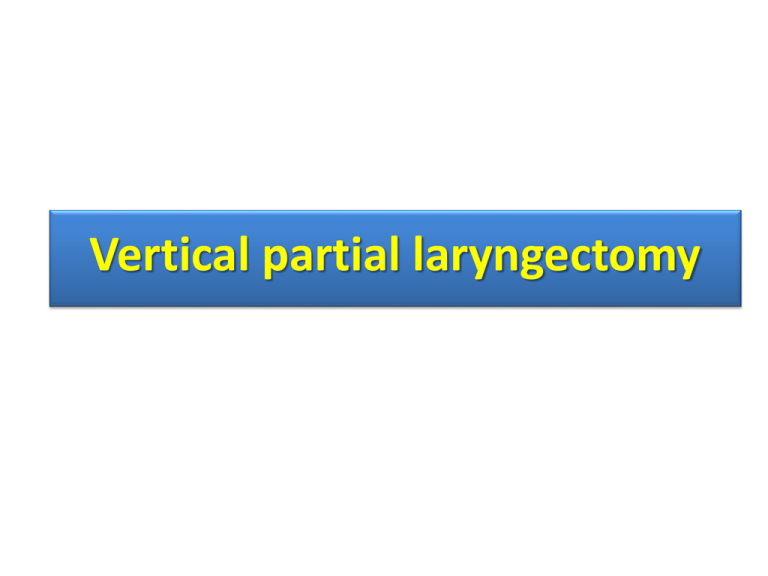
Vertical partial laryngectomy Indications to VPL • T1, T2 glottic lesion Contraindications to VPL Fixed TVC Involve posterior commissure Bilat. arytenoid invasion Bulky transglottic lesion Thyroid cartilage invasion >10 mm subglottic extension anteriorly; >5 mm posteriorly Hemilaryngectomy Hemilaryngectomy • The partial excision of the larynx which is a voice-conserving procedure • Consists of dividing the thyroid cartilage in the midline and resecting in continuity the thyroid cartilage with the corresponding true and false vocal cords and ventricle Hemilaryngectomy Oncologic results T1 lesions : • Local control rates >90% • Local recurrence rates 0 - 11% – Without anterior commissure involvement : local control rates 93% – Anterior commissure involvement without impaired mobility or extension beyond the glottis : local failure rate 25%, most common site of recurrence is subglottis Oncologic results • T2 glottic : Local recurrence rate >14% High local failure rate for 1) Subglottic extension with cricoid cartilage invasion 2) Supraglottis extension through ventricle (possibility of thyroid cartilage invasion) 3) Impaired cord mobility (TA muscle invasion within paraglottic space) • T3 glottic : Local failure rates of >36% Extended procedures Anterior frontal / Frontolateral vertical hemilaryngectomy Posterolateral vertical hemilaryngectomy Extended vertical hemilaryngectomy Frontolateral vertical hemilaryngectomy Indication • Lesion involve anterior commissure • Lesion involve opposite TVC anteriorly < ant 1/3 Contraindication • Tumor extend posteriorly beyond the tip of vocal process, into ventricle or below the inferior surface of cord • Vertical thyrotomy made through thyroid lamina of the less involved side • Allowing for removal of the anterior angle of thyroid cartilage, anterior commissure, and a portion of contralateral true vocal cord Post op Frontolateral vertical hemilaryngectomy Anterior frontal partial laryngectomy Posterolateral vertical hemilaryngectomy • The thyrotomy approach same as standard operation, and modification lies in posterior extension of resection to encompass part or all of ipsilateral arytenoid cartilage and mucosa Indication • Tumor extend posteriorly to involve ipsilateral arytenoid mucosa Extended vertical hemilaryngectomy • Resection of entire ipsilateral hemilarynx with resecting superior aspect of cricoid cartilage • For glottic lesion with subglottic extension Cricoid cartilage Reconstruction • (1) False vocal cord pulldown • (2) Cartilage preservation with perichondrial/sternohyoid bipedicle muscle flap reconstruction • (3) Epiglottic reconstruction for defects involving the anterior commissure Reconstruction Imbrication laryngoplasty Bipedicle muscle flap SUPRACRICOID PARTIAL LARYNGECTOMY WITH CRlCOHYOlDEPlGLOlTOPEXY (SCPL-CHEP) Surgical resection (SCPL-CHEP) • Removal of both TVCs and FVCs, bilat paraglottic spaces, preepiglottic space, thyroid cartilage, (maximum one arytenoid) Indication T1b : involved anterior commissure T1 : contralateral various dysplasia and hyperplasia area T2 : bilateral glottic cancer Selected T3 Contraindication • CA joint fixation Subglottic extension to level of cricoids or direct invasion of cricoids Invade interarytenoid area Extent to outer perichondrium of thyroid cartilage (Extralaryngeal spread) Involved pharyngeal wall, valleculae, BOT, postcricoid, Pulmonary impairment,GERD, age>70 yrs (prefer lung function test) Surgical technique • Upper: – Along post. Sup. Of thyroid cartilage • Elevated off pyriform mucosa • Disarticulate cricoarytenoid jt • Lower: – Superior border of cricoid cartilage • Transection posterior to ventricle, anterior to vocal process Surgical technique Extended SCPL • Anterior subglottic extension • Resection of the anterior arch of cricoid • Closed with pexy between the first two tracheal rings and the hyoid or tracheohyoidoepiglottopexy Functional outcome • • • • Temporary dysphagia But long-term dysphagia: rare Intractable aspiration 0-4% NG post-op: 9-50 days Supraglottic cancer Transoral laser microsurgery Horizontal Partial Laryngectomies •Supraglottic Laryngectomy Supracricoid Laryngectomy with Cricohyoidopexy (CHP) EXTENDED PROCEDURES •ARYTENOID, ARYEPIGLOTTIC FOLD, OR SUPERIOR MEDIAL PYRIFORM INVOLVEMENT FROM SUPRAGLOTTIC CARCINOMA. •BASE OF TONGUE EXTENSION FROM SUPRAGLOTTIC CARCINOMA. EXTENDED PROCEDURES. Supraglottic laryngectomy Surgical resection • Removal of both FVCs and AE folds, epiglottis, preepiglottic space, upper half thyroid cartilage, hyoid bone (one arytenoid for extended procedure) • Preserve both TVC, arytenoids, BOT Indication • Supraglottic cancer T1, T2 Contraindication Invasion of cricoids and/or thyroid cartilage Bilateral mucosal invasion of arytenoid cartilage Invasion of posterior and anterior commissure Fixation of arytenoid cartilage Involvement of BOT < 1 cm to circumvallate papillae Impair tongue base mobility (involved deep intrinsic muscle) Invade FOM with valleculae involvement Bailey Surgical technique Sternohyoid and sternothyroid muscles transected at superior border of thyroid cartilage. Surgical technique Perichondrium incised at upper border of thyroid cartilage Surgical technique Elevate external thyroid perichondrium halfway down the thyroid cartilage. Surgical technique Oncologic outcome • For T1, T2 local control rate >90% SUPRACRICOID PARTIAL LARYNGECTOMY WITH CRICOHYOIDOPEXY (SCPL-CHP) Surgical resection • Removal of both TVCs and FVCs, bilat paraglottic spaces, preepiglottic space, thyroid cartilage, epiglottis, (extended resect one arytenoid) Indication • T1, T2 supraglottic CA with anterior commissure, ventricle and glottic involvement • T3 supraglottic CA (paraglottic and preepiglottic involvement) • Selected T4 supraglottic CA (local cartilage invasion) Contraindication Arytenoid cartilage fixation Subglottic extension >10 mm anteriorly, >5 mm posteriorly or direct invasion of cricoid Extensive preepiglotte space invasion Tumor extend to hyoid bone superiorly or cricoid cartilage inferiorly Extension to pharyngeal wall ,valleculae, BOT,interarytenoids and postcricoid Cummings Open Conservation Laryngeal Surgery Early glottic cancer • Laryngofissure and cordectomy • Vertical partial laryngectomy Supraglottic cancer • Horizontal partial laryngectomy (Supraglottic – Hemilaryngectomy laryngectomy) – Frontal/Frontolateral • Supracricoid partial laryngectomy laryngectomy with • Supracricoid partial cricohyoidopexy laryngectomy with cricohyoidoepiglottopexy (SCPL-CHP) (SCPL-CHEP) Postoperative management • Deflate tracheostomy tube early as possible • Remove tracheostomy tube day 3-5 – Kept prolong if laryngeal edema or salivary stasis • Swallowing rehabilitation not begun until tracheostomy tube is removed, stoma is closed and can swallow her/his saliva • Speech rehabilitation early post-op


